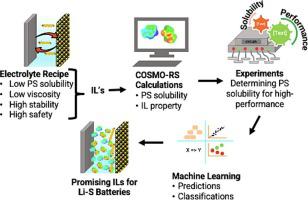当前位置:
X-MOL 学术
›
Chem. Eng. J.
›
论文详情
Our official English website, www.x-mol.net, welcomes your feedback! (Note: you will need to create a separate account there.)
Selection of ionic liquid electrolytes for high-performing lithium-sulfur batteries: An experiment-guided high-throughput machine learning analysis
Chemical Engineering Journal ( IF 13.3 ) Pub Date : 2024-04-23 , DOI: 10.1016/j.cej.2024.151562 Aysegul Kilic , Omar Abdelaty , Muhammad Zeeshan , Alper Uzun , Ramazan Yildirim , Damla Eroglu
Chemical Engineering Journal ( IF 13.3 ) Pub Date : 2024-04-23 , DOI: 10.1016/j.cej.2024.151562 Aysegul Kilic , Omar Abdelaty , Muhammad Zeeshan , Alper Uzun , Ramazan Yildirim , Damla Eroglu

|
The polysulfide (PS) shuttle mechanism (PSM) is one of the most significant challenges of lithium-sulfur (Li-S) batteries in achieving high capacity and cyclability. One way to minimize the shuttle effect is to limit the PS solubilities in the battery electrolyte. Ionic liquids (IL) are particularly suited as electrolyte solvents because of their tunable physical and chemical properties. In this work, thousands of ILs are screened to narrow down potentially viable candidates to be used as electrolytes in Li-S batteries. To that end, the COnductor-like Screening Model for Realistic Solvents (COSMO-RS) calculations are performed over more than 36,000 ILs. An extensive database containing PS solubilities and other relevant properties is constructed at 25 °C. First, the effectiveness of the COSMO-RS calculations is experimentally tested with six different ILs having a wide range of solubility and viscosity values; a strong correlation between the PS solubility and battery performance is obtained. After specifying the target limits for promising ILs using the experimental battery performance data, machine learning (ML) tools are used to predict and identify the relationship between IL properties and PS solubilities and structural and molecular descriptors of ILs. The extreme gradient boosting (XGBoost) method successfully predicts the solubility and property values. Association rule mining (ARM) and the feature importance analysis show that anion descriptors are more dominant, whereas cations have less impact on the solubilities and properties of ILs. Finally, the imidazolium and pyridinium ILs with bis_imide and borate anion groups are identified as the most promising ones.
中文翻译:

高性能锂硫电池离子液体电解质的选择:实验引导的高通量机器学习分析
多硫化物(PS)穿梭机制(PSM)是锂硫(Li-S)电池实现高容量和可循环性的最重大挑战之一。最小化穿梭效应的一种方法是限制 PS 在电池电解质中的溶解度。离子液体 (IL) 由于其可调节的物理和化学性质而特别适合作为电解质溶剂。在这项工作中,筛选了数千种离子液体,以缩小可用作锂硫电池电解质的潜在可行候选者的范围。为此,我们对超过 36,000 个 IL 进行了类似 COnductor 的现实溶剂筛选模型 (COSMO-RS) 计算。在 25°C 下构建了包含 PS 溶解度和其他相关特性的广泛数据库。首先,使用具有广泛溶解度和粘度值的六种不同离子液体对 COSMO-RS 计算的有效性进行了实验测试; PS 溶解度和电池性能之间存在很强的相关性。使用实验电池性能数据指定有前景的离子液体的目标限制后,使用机器学习 (ML) 工具来预测和识别离子液体特性和 PS 溶解度以及离子液体的结构和分子描述符之间的关系。极限梯度增强 (XGBoost) 方法成功预测了溶解度和属性值。关联规则挖掘(ARM)和特征重要性分析表明,阴离子描述符占主导地位,而阳离子对离子液体的溶解度和性质影响较小。最后,具有双酰亚胺和硼酸盐阴离子基团的咪唑鎓和吡啶鎓离子液体被认为是最有前途的离子液体。
更新日期:2024-04-23
中文翻译:

高性能锂硫电池离子液体电解质的选择:实验引导的高通量机器学习分析
多硫化物(PS)穿梭机制(PSM)是锂硫(Li-S)电池实现高容量和可循环性的最重大挑战之一。最小化穿梭效应的一种方法是限制 PS 在电池电解质中的溶解度。离子液体 (IL) 由于其可调节的物理和化学性质而特别适合作为电解质溶剂。在这项工作中,筛选了数千种离子液体,以缩小可用作锂硫电池电解质的潜在可行候选者的范围。为此,我们对超过 36,000 个 IL 进行了类似 COnductor 的现实溶剂筛选模型 (COSMO-RS) 计算。在 25°C 下构建了包含 PS 溶解度和其他相关特性的广泛数据库。首先,使用具有广泛溶解度和粘度值的六种不同离子液体对 COSMO-RS 计算的有效性进行了实验测试; PS 溶解度和电池性能之间存在很强的相关性。使用实验电池性能数据指定有前景的离子液体的目标限制后,使用机器学习 (ML) 工具来预测和识别离子液体特性和 PS 溶解度以及离子液体的结构和分子描述符之间的关系。极限梯度增强 (XGBoost) 方法成功预测了溶解度和属性值。关联规则挖掘(ARM)和特征重要性分析表明,阴离子描述符占主导地位,而阳离子对离子液体的溶解度和性质影响较小。最后,具有双酰亚胺和硼酸盐阴离子基团的咪唑鎓和吡啶鎓离子液体被认为是最有前途的离子液体。









































 京公网安备 11010802027423号
京公网安备 11010802027423号